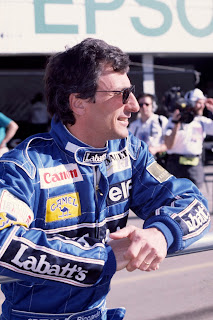Career defined by unwanted record
The racing driver Andrea De Cesaris, who competed in 15 consecutive Formula One seasons between 1980 and 1994, died on this day in 2014 as a result of injuries sustained in a motorcycle accident.
Andrea De Cesaris at the wheel of the Marlboro
McClaren he drove in his first full F1 season
De Cesaris, who was 55, lost control of his Suzuki motorcycle on Rome’s orbital motorway, the Grande Raccordo Anulare, and collided with a guard rail.
The Rome-born driver, the son of a tobacco merchant, retired from competition with the unwanted record of having never won a race in 208 Formula One starts, the most by any driver without a victory to his name in the sport’s history.
He needed no second invitation to hit the accelerator on the track but his daring often veered towards the wild and erratic and had a reputation for being accident prone, putting not only himself but other drivers at risk. A facial tic reinforced the perception of some rivals that he was slightly mad.
His tendency to drive into trouble gave him a number of other records he would have preferred not to have earned: the most consecutive non-finishes, 18 between 1985 and 1986, although that includes mechanical failures, the most successive non-finishes in a single season, 12 in 1987, when he also set the record for the most non-finishes in a single, 16-race season, at 14.
 |
| De Cesaris raced for 15 seasons in Formula 1 but never won |
The British-based team, which ran him alongside John Watson, a five-time GP winner, did not extend his contract beyond the 1981 season.
Yet, having entered F1 with a record of success in karting, Formula Three and Formula Two, De Cesaris was never without a team.
In all, he represented 10 teams during his career and in only one season, when he drove for Minardi in 1986, did he fail to register a point.
His best years came with Alfa Romeo in 1982 and 1983, when he achieved three of his five career podium finishes.
In 1982, De Cesaris became at 23 the youngest man ever to take pole position at the Long Beach Grand Prix, which made him only the second Alfa Romeo driver to capture a pole in 30 years. In the same season he finished third in the Monaco GP and sixth in the Canadian GP in Montreal.
He might have claimed second place in Monaco had he not ran out of fuel on the last lap when in a position to potentially pass Didier Peroni.
 |
| De Cesaris driving for Sauber in the 1994 British Grand Prix in his final competitive season |
Alfa's withdrawal after the 1983 season left him without a drive but he was soon hired by Ligier for two seasons, and subsequently represented Minardi, Brabham, Rial, Dallara, Jordan - alongside Michael Schumacher - Tyrrell and Sauber.
Sauber’s car was unreliable and De Cesaris decided to retire at the end of the 1984 season, when he finished sixth in the French GP at Magny-Cours in France but was let down by his engine in failing to finish any of the next seven races.
Away from racing De Cesaris became a successful currency broker in Monte Carlo, a career he combined with a new sporting passion in windsurfing, in pursuit of which he travelled the world. He bought a house in Hawaii to use as his windsurfing base.
His funeral took place at the church of San Roberto Bellarmino in the Parioli district of Rome.
Travel tip: 
The now-abandoned Pista d'Oro karting circuit
just outside Rome, where De Cesaris once raced
Some of De Cesaris’s earliest racing experience was gained at the now-abandoned Pista d’Oro, a karting stadium in Rome where Italian drivers of the calibre of Elio De Angelis, Emanuele Pirro, and Giancarlo Fisichella and even current world champion Lewis Hamilton have competed. The stadium was situated about 20km (12 miles) east of Rome at Tivoli Terme on the Via Tiburtina, which follows the route of the Roman road of the same name that linked Rome with Aternum (the modern Pescara) on the Adriatic coast. It was built by the Roman consul Marcus Valerius Maximus around 286BC, and covered a distance of approximately 200km (124 miles).
Travel tip:
The church of San Roberto Bellarmino
in the Parioli district of Rome
The Parioli district is one of Rome's wealthiest residential neighbourhoods. Located north of the city centre, it is notable for its tree-lined streets and elegant houses, and for some of Rome's finest restaurants. The Auditorium Parco della Musica and the Villa Ada, once the Rome residence of the Italian royal family and surrounded by the second largest park in the city, can also be found within the Parioli district.
Also on this day:
1658: The birth of Mary of Modena, queen consort of England
1712: The birth of painter Francesco Guardi
1928: The birth of painter Alberto Sughi




